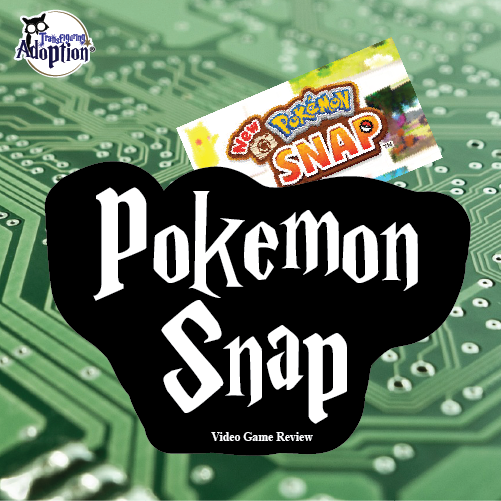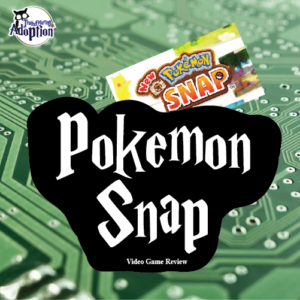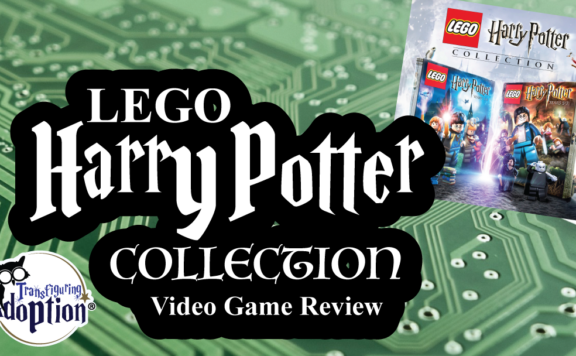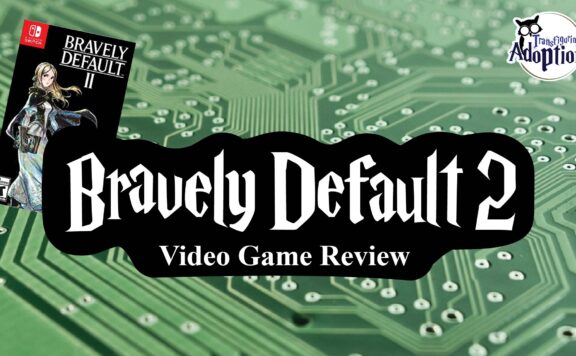[Download PDF Guide]
Grade:
Transfiguring Adoption awarded this game 4 Hoots out of 5 based on how useful it will be for a foster/adoptive family. [Learn more about our Hoot grading system here]
Game Info:
- Rating: ESRB – E for Everyone, PEGI 3+
- Genre: Adventure, Simulation, Shooter
- Platform(s): Nintendo Switch
- Studio: Nintendo/Creatures Inc./GAME FREAK inc./HAL Laboratory, Inc.
From the Cover of New Pokemon Snap (2021) by Nintendo:
“Become a Pokemon photographer! Spot Pokemon in their natural habitats and catch ‘em all on camera! Get your in-game photos scored by the professor! Create your very own Pokemon Photodex! You can edit your photos and share them with the world!”
Transfiguring Adoption’s Overview:
The target audience appears to be children that are 6 and up, depending on your child’s gaming ability. This is a great game for any family to enjoy with very few triggers or sequences of violence common with many games. While there are no overt ties to foster care, there is a positive relationship built between children and a competent, trustworthy adult as the main character (who is implied to be a child as the average Pokemon Trainer in-world starts their journey at age 10). This is also a great low-adrenaline game as well that still can have some of the stylings of a first-person shooter game since the object is to swivel around, zoom in on targets, and take photographs.
Caregivers can give special attention to positive interactions between characters (humans and Pokemon alike), problem-solving skills, and the ability to creatively adapt to situations. For children that have endured trauma there can also be excellent conversations about forming positive relationships with safe adults or mentors, adapting to challenges and change, and connecting feelings to behavior for themselves and others because of the interactions that take place in this unique game.
NO SPOILERS IN THIS SECTION!!!
** Spoilers Could Be Ahead **
How Is This Relevant To Adoption & Foster Care?
The main character in this game is tasked with helping the prestigious Professor Mirror in helping collect data on the local Pokemon populations via building a Photodex, a mechanism similar to Pokedexes of other games where the player develops a portfolio of each Pokemon species’ behaviors, appearance variants, and other unique pieces of information. This journey is inspired by an adventure book written and left partially incomplete by a famous explorer. Over time the player works with a research team to compile new information about this region and the Pokemon that live within it to solve the mystery of the “Illumina Pokemon” that legend says protected the planet from danger in the past.
At face value this does not appear to be a game that would appeal to foster children but, let’s be honest, the Pokemon franchise has been exceptionally successful across multiple generations now and is clearly not disappearing anytime soon. Another reason this game may appeal to your child is because your child will be able to easily see themselves in the main character they can personalize with a name and appearance before they even start the game. This game will allow your child to act with confidence and independence in a way they may not feel able to in real life. Another reason this game may draw a crowd is the low-adrenaline experience trundling through these beautiful, peaceful levels. Sure there are occasional Pokemon jumping out but this is vastly different from other games where stakes feel higher and character or comrade death is a potential risk. This game overall feels safe and welcoming in ways that your child may desire to feel as they navigate coming into your care and learning to feel safe.
Discussion Points:
- Respectful Relationships
Children that have endured trauma often do not see adults as a source of comfort or safety due the abuse or neglect they have endured. Due to these experiences children may struggle to form positive, respectful relationships with safe adults. This is especially true when working with a sibling group where one sibling has had to step in and be an auxiliary adult in caring for the siblings, resolving conflict, and sometimes even caring for their parents in some ways. Seeing the main character, Rita, and Phil have positive, respectful relationships where the adults are seen as mentors and leaders can be a great experience for a child that has seen too many movies with incompetent, uncaring, or even dangerous adults. Professor Mirror and Todd Snap both provide positive associates with adults with appropriate relationships with children and can help your child see that safe adults can be trusted. - Adapting to Challenges and Change
Don’t we all wish we had a do-over in life? Or like in this game that we could re-do a level for a better outcome? While we may not be able to pause, reset, or delete embarrassing or painful files, human beings can learn to adapt in the face of challenges or change. For children that have endured trauma, it’s often hard to “keep going” when they make a mistake due to past experiences. Moving forward is hard when you can’t talk to your mom when you want or go laugh with your sibling when you need a break because you are in foster care. It’s easy to just want to give up. However, caregivers can work with their children on understanding how to watch for opportunities for growth instead of avoiding feeling defeated or like a failure. I loved the basis on how Professor Mirror gives notes on photos with a strength based perspective. As I played the game this calm demeanor often encouraged me to keep playing even when I felt frustrated by not completing a photo request. The prompts for changing my approach or settings were immensely helpful and reflect how a caregiver can offer a calm, strength-based approach to helping their child solve problems.
- Connecting Feelings to Behavior
This may seem like a very basic concept, but for a child that has endured trauma the skill of identifying cause and effect can be as difficult for them as it may be for you to understand why your teenager is making excited-pterodactyl noises at 10:00pm in response to a TikTok video. They are missing the connection between the two because they haven’t been given the opportunity to experience it themselves. When a child has endured trauma this restructures the brain to rely more on the fight-or-flight responses that kept them safe. So instead of taking the country-road processing path to the prefrontal cortex to make decisions and responses they are taking the expressway to the limbic system to act quickly and get to safety. This is great when avoiding abuse or surviving neglect… but not so great when they are out of that environment. The great news is that children can be taught to take the country road with lots of patience and practice from a loving caregiver that can help them connect their own feelings to their behavior, like they do when they connect how a Pokemon may feel or react when given stimuli from playing music, interacting with other Pokemon, having an Illumina orb tossed at them or a Crystal Bloom, or a Fluffruit.
Cautionary Points:
- Limited Online Interaction With Strangers
If you have a membership to Nintendo Switch Online your child may activate some online features that allow them to give points to other players with neat photos and edits. This is extremely limited to a thumbs up/down type feature and does not allow comments so overall this is a pretty low risk. The only thing I could find that will need extra monitoring is ensuring that your child does not include too much personal information in their character name (i.e. – no last names, DOB, etc.) and there is one short sentence area they could potentially personalize to put personal information. This fillable area includes a pre-typed message about being a beginning photographer but an extra creative child could put Snapchat handles or phone numbers with the character allowances. There is no prompt for this, but again if your child struggles in that area that may be an area to closely monitor.
- Very Limited Risk of Cyber Bullying
If you have a membership to Nintendo Switch Online your child may activate some online features that allow them to give points to other players with neat photos and edits. This is extremely limited to a thumbs up/down type feature and does not allow comments so overall this is a pretty low risk. I also could not locate a way to search for individual players so there is a lower risk of cyber bullies seeking specific players and targeting their photo profile.
- Some Cartoon Violence
Since most Pokemon interact with each other there is plenty of room for conflict and shenanigans. As a result there are some sequences of Pokemon antagonizing or fighting one another. This is all limited to very tame cartoon violence without blood or lasting consequence (i.e. – visible injury, death, etc.) but if your child is prone to mimicking violence seen in media this may be an area to monitor your child and prepare for discussion about appropriate interactions.
- Some Sequences of Elemental Danger
Many Pokemon use elemental-based attacks so this may be potentially triggering if your child is extra sensitive to such elements in gameplay. The games are done in natural environments with wild Pokemon as well and while the character never appears to be in danger, some children may not be too keen about levels going into volcanos or deep ocean depths.
Discussion Guide:
- Who is your favorite L.E.N.S. kid team member? Why do you like them?
Caregiver Note: This is a good introductory question to help ease your child into conversation. Children often struggle with being put on the spot with big questions so it’s good to start the conversation off naturally by giving them a chance to connect with a character they like. - Which mentor is that character closest to? Why do you think those characters get along so well?
Caregiver Note: For a child that has picked the main character or Rita they will likely say Professor Mirror and if Phil they will point to Todd Snap. Help your child process how these adults treat and speak to their mentees. Some may include that they are kind, patient, respectful, open to listening to the kids, positive, and don’t talk down to the kids. This will help your child break down positive points about safe adults to help differentiate from unsafe adults. - What adults do you feel that close to? How are they like Professor Mirror or Todd?
Caregiver Note: This is a way to turn this theme towards your child. Be prepared if they talk about adults in their life from before you were their caregiver. If your child struggles to connect to an example, point out some of the traits they mentioned about Professor Mirror or Todd to help narrow those down. This may be a difficult question but will help your child connect safe traits to safe adults. This can also help caregivers gain perspective on how a child views adults in their life and take note on ways to help your child feel more comfortable with you. - When you play the Elsewhere Forest the seasons keep changing. How does that work?
Caregiver Note: On this level in particular the seasons change based on how the player interacts with Espeon. If you throw an apple to it, play music, or throw an Illumnia Orb at it at different points at the start of the level Espeon will send the player on a path through a specific season. If no action is taken the sequence is randomly selected. With this in mind you may be able to help your young player get through this level with some gentle suggestions on how to interact with different Pokemon that appear at the start of the level. The clue given in the game is on the floating rock being controlled by a pokemon. When music is played the Trevenant (the spooky tree Pokemon) will move to reveal a new path option for two of these seasons and Espeon will follow you and that can be a segway to help hint. This can also help you in discussing the game. - When you get stuck and feel frustrated at home or at school, how can I help you find another path to figure out what to do?
Caregiver Note: This is another question that helps you talk to your child about how to reset a tense situation or to help prompt your child through hard decisions or emotions. Often when children have endured trauma it’s very difficult to access the prefrontal cortex of the brain without stress, but stress will make that journey from feeling to thought even more difficult! It’s easier to react on impulse to what the limbic system says to do (fight, flight, freeze, or checking out) than to go through all those mental hurdles. This can be remedied over time with lots of practice using that prefrontal cortex to think through a problem before implementing an action. This can give you a chance to discuss an action plan for when your child feels stuck with an emotion or a problem so that they don’t give up in fear of failure or embarrassment. - ACTIVITY: ACTIVITY: Who’s that Emoticon?
Caregiver Note: For this activity you will need some white paper plates, coloring tools like crayons, a permanent marker, and if you’d really like to get into it feel free to grab some glue sticks, scissors, and construction paper. Work with your child to create their favorite Pokemon’s face when they hear music (silly), when they get hit with a Fluffruit (angry), have an Illumina Orb (brave/powerful), and when they are alone (sad/afraid), and when they are with friends (happy). Color and design these while discussing the game. Afterwards you can play a variant of “Who’s that Pokemon?” from the original TV show to practice identifying feelings that result from behaviors. Start off using the connections to feelings listed above that helped create the emotion. Then go back and forth asking one another Who’s That Pokemon about different situations. For example, “Who’s that Pokemon when someone says mean things about my pictures?”. This will give caregivers insight on what their child may be experiencing with their peers and how they are really feeling behind tough or overly happy facades while giving your children the opportunity to practice language expression connecting feelings to behavior that they very much need. - Why do the Pokemon get excited when you throw the Fluffruit at their feet but upset when you throw it at them directly?
Caregiver Note: This is another question that will help your child connect that different actions have different emotional consequences for the Pokemon they interact with. They get excited to see Fluffruit because it’s a yummy treat and, of course, get excited before, during, and after the experience of the treat. However, when one is thrown directly at them that probably hurts to some extent. I mean, I love a good Honey Crisp apple but if someone lobbed that at my head I’d be experiencing a lot of emotions. Hurt, sadness, frustration, and even anger would rank up there. Of course there is nothing wrong with how I feel about that… if anything I’d be very validated in those feelings! But, taking that moment to identify those emotions is a piece of the response-puzzle is often what your child is missing when they experience emotions, so they will have a hard time taking a deep breath and asking for assistance rather than cussing out or retaliating against the serial apple-thrower. By practicing using words to name their emotions they can learn to tame them, as Dr. Daniel Siegel says in his talks about adolescent brain development and trauma (seriously, read up on him if you haven’t heard of him!!) - When that Pokemon has a Fluffruit thrown at them directly, who decides how they react?
Caregiver Note: As we discussed above, your child needs to also recognize that no one can “make” them act any sort of way. While our emotions are absolutely valid and understandable when someone lobs an apple at us, if we go on a venge-filled rampage of apple throwing we ourselves will receive a hefty consequence for such behavior. This question will help your child connect that just as that Espeon is responsible for reacting in zapping you to another season after being hit with a Fluffruit or an Illumina Orb, they are responsible for how they respond to their emotions. - When someone does something like throwing a Fluffruit at you how can I help you make good decisions about how to respond?
Caregiver Note: This is another question that will allow you, as a caregiver, to help your child to come up with a plan for how to respond to hard situations while they are calm and better able to think clearly using that beautiful prefrontal cortex they are growing. When the brain is emotionally escalated it is even more difficult to use the prefrontal cortex due to the time and distance required to process a situation and develop a thoughtful response. In short, the angrier we get the more likely we will rely on the impulsive limbic system that does not account for consequences or future challenges. The limbic system is worried about safety right now, not later. So now you and your child can come up with a plan for helping them regulate their emotion once identified, talking about that emotion, and then calmly finding a solution for the challenge. - Activity: Lifebook Requests
Caregiver Note: When a child enters the child welfare system there is often a huge gap for that child in terms of pictures, souvenirs, and other connections to memories. To help with this many agencies in the USA are asking caregivers to work on Lifebooks with their children in care. This can not only be a fun, ongoing activity to do with your child as you create memories together and with any other important connections to your child this also creates a scrapbook or album of those years to honor the experiences and people important to your child. If you’ve never done one you may structure this like the Photodex from the game, or if you already have a Lifebook started you could do a page modeled after a Pokemon’s profile and have 4 photos you stage together to show your child “in their environment” like the game. Feel free to get as creative with this as you’d like in terms of scrapbooking and how you take the photos, but again consider this to be an ongoing part of your parenting so your child can look back on all the wonderful memories they made while in your care, whether you only have your child for a season or for a lifetime. For more information about Lifebooks in general, feel free to check out this resource from Tennessee DCS – https://files.dcs.tn.gov/policies/chap16/16.8Att-GuidelinesforLSB.pdf






